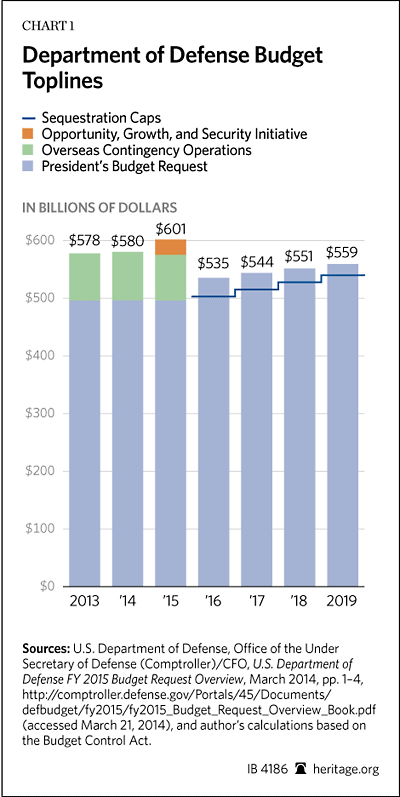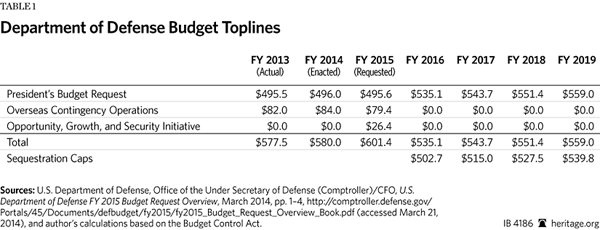The Obama Administration recently released its annual budget request for the Department of Defense (DOD) for fiscal year (FY) 2015. Over the past several years, the DOD’s annual President’s Budget Requests (PBR) have grown increasingly complicated, if not outright unhelpful. Due to the uncertainty of sequestration, the lack of appropriations bills, and politics, recent budget requests provided to Congress by the DOD were rarely indicative of how the military would actually be funded.
Initially, there was hope that this year’s budget request would finally give clarity on how the military would deal with the recent budget cuts. However, the FY 2015 budget request is proving to be the most confusing one yet. In practice, the DOD’s budget is only a request for funding it believes necessary to carry out its function and is a starting point for congressional debate on the matter. Congress has many options before it, but the first step is to understand what is and is not included in the DOD FY 2015 PBR.
The Ins and Outs of the FY 2015 PBR
This year, the DOD attempted to tie strategy to its budget request by releasing the 2014 Quadrennial Defense Review (QDR) at the same time as the budget. The merits of the 2014 QDR aside, the DOD would use the “updated defense strategy” to inform how to prioritize funding in the FY 2015 budget request.[1] In addition, the DOD also tried to be more mindful of the defense toplines stated under current law. The result was an awkward blend of multiple budget toplines that, simply put, do not add up.

The characteristics of the FY 2015 PBR are as follows:
- The defense request for just FY 2015 is compliant with budget toplines. The Bipartisan Budget Act of 2013 set spending caps for FY 2014 and FY 2015. The base budget request does stay within the spending caps for FY 2015.
- There are two supplemental requests for FY 2015. In order to stay within the topline but still fund some of the needed military priorities, the Obama Administration is submitting a separate request for funding through the Opportunity, Growth, and Security Initiative (OGSI). The defense portion of OGSI, amounting to $26.4 billion,[2] would pay for requirements that did not make it into the base FY 2015 budget request. The second supplemental budget vehicle, the Oversees Contingency Operation (OCO) fund, has been a mainstay of the budget over the past decade. The details of the OCO request is not yet available but is estimated to be $79.4 billion.[3]
- The DOD’s budget from FY 2016 to FY 2019 is above sequestration. Sequestration from the Budget Control Act (BCA) of 2011 will resume in FY 2016. The FY 2015 PBR exceeds these caps by about $115 billion.[4] The DOD does attempt to get closer to the BCA topline and lowered its budget request by $113 billion from the previous year’s request.[5]
- The budget includes savings from contentious initiatives and reforms. The budget assumes that it will be able to contain cost growth through initiatives such as base closures, military compensation adjustments, and health care adjustments. The inclusion of these assumed savings gives the DOD more space to fund other priorities while staying close to the spending caps.
The DOD justified the higher defense topline by claiming that it was funding the military to meet the strategy laid out by the 2014 QDR with acceptable levels of risk. However, the FY 2015 PBR does not fully fund the force structure levels mentioned in the QDR. What the FY 2015 PBR actually funds is:
- 10 carriers. The QDR makes mention of an 11-carrier force, but the midlife refueling for the USS George Washington, scheduled for FY 2016 and necessary to achieve an 11-carrier force, is not in this budget.[6] To obtain to an 11-carrier fleet, the DOD will either have to request an even higher amount for FY 2016 or make drastic cuts (of about $4.7 billion)[7] to major programs in that year.
- The smaller end strength option. The QDR makes reference to an end strength goal of 450,000 active Army personnel and 182,000 active Marines, which would require funding above sequestration levels. But the FY 2015 PBR is assuming the sequestration-size end strength of 420,000 active Army and 175,000 active Marine personnel. The defense topline required to meet the end strength goal is unclear.[8]
In short, the DOD sets goals for a defense force structure that requires a non-sequestration environment, but their non-sequestration version of the budget cannot fund it.
The permutations of budget scenarios are numerous, but here are some possible ways the FY 2015 PBR would actually add up given different budget toplines:
- Sequestration and no cost savings. This would be the worst-case scenario. If sequestration resumes in FY 2016 and the DOD is prevented from executing on some or any of their proposed cost savings, funding for the sequestered force structure may not be possible without major cuts to procurement programs and retiring additional assets.
- Using the DOD FY 2015 PBR toplines. Even if the military is able to gain savings through reforms, it is unclear how the DOD will reach its end strength goals (e.g., 11 carriers) under this budget topline. At this proposed level, the DOD would have to forgo the goals set out in the QDR or make additional cuts to investment accounts and divest further assets.
- Fund the DOD to meet their goals. If the DOD is to meet its end strength goals without making additional drastic cuts to program funding or divesting from readiness, the defense budget will have to exceed the current topline as stated in the FY 2015 PBR. The situation will only worsen if the DOD is prevented from slowing cost growth in operations and maintenance and military personnel.
What This Means for Congress
Congress must first decide on the fate of this fiscal year, FY 2015. The major decision would be whether to fund OGSI and how much of OCO to approve.
Congress must then decide what happens in FY 2016 and beyond. This is pivotal: The DOD has delayed many decisions to next year’s budget request, and the lack of budget clarity from Congress will lead to extremely poor decisions for the military.[9]
Even at the force structure outlined in the 2014 QDR, the military will still incur higher risk and will be ill-equipped to meet the U.S. national security requirements. However, at this point in time, the DOD is closer to the worst case than the ideal. Congress should find a way to fully fund defense.
—Diem Nguyen Salmon is Senior Policy Analyst for Defense Budgeting in the Douglas and Sarah Allison Center for Foreign and National Security Policy, a division of the Kathryn and Shelby Cullom Davis Institute for International Studies, at The Heritage Foundation.




